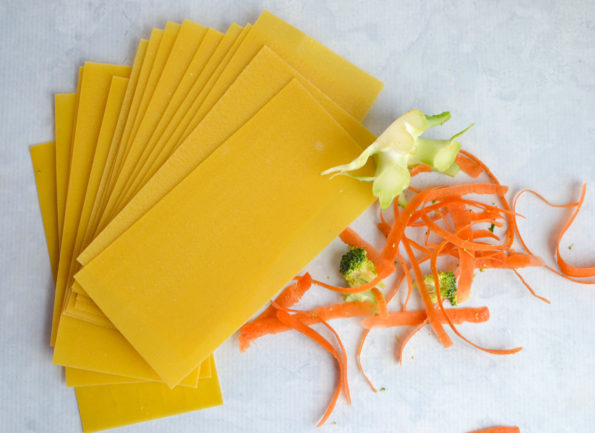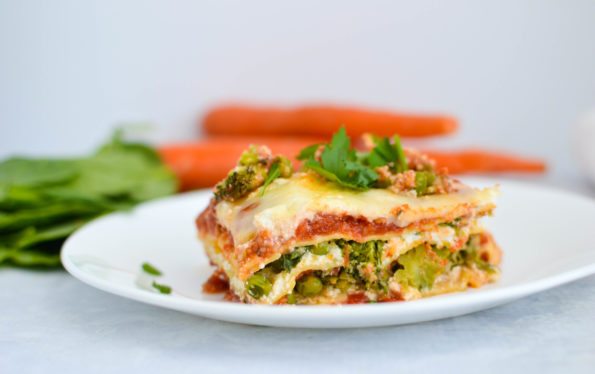Put those nutritious vegetable scraps to good use this Earth Day! Try this Healthy Spring Vegetable Lasagna and learn more about ways to reduce food waste!
I am very happy to introduce you to a new colleague of mine in the food blogging world! Jenna Gorham, a Registered Dietitian in Bozeman, Montana, will be sharing some amazing facts about food waste and helpful tips to reduce it! At the end of the article, don't forget to check out my vegetable lasagna recipe!

Guest Blogger: Jenna Gorham
I’m excited to be here on Katie’s blog today, especially in honor of Earth Day! This month’s Recipe Redux theme involves preventing food waste. I’m a big proponent of reduce, reuse, recycle and I love applying it in the kitchen. It’s estimated that approximately 30-40% of food produced for human consumption is wasted -from farms to processing facilities to grocery stores and restaurants and even in our own homes. Food waste is a national concern not only because of the millions of Americans going hungry each day but also because of the economic and environmental impacts.
Why Should We Care About Food Waste?
- When we waste food, we’re also wasting valuable natural resources, including land, water, labor, and energy…
- 25% of our freshwater supply and 300 million barrels of oil are used to produce food that is wasted
- Food waste is a huge contributor to methane production...
- Landfills are one of the largest sources of methane production in the country and food waste is the largest component filling up our landfills.
- According to National Geographic, “Producing the food we throw away generates more greenhouse gases than most entire countries do,” that’s 135 million tons of greenhouse gases each year.
- Over 40 million Americans continue to go hungry each day…
- That’s 1 in 7 people going to bed without dinner or not knowing where their next meal will come from
- We’re throwing money in the trash...
- As a country, $250 billion dollars each year, to be exact.
- The average family in the U.S. throws away an average of $640 each year in food waste alone.
You can read more here, here, and here.
Did you know 39% of food wasted is fruits and vegetables?
As much as it bothers me to see someone de-stem a strawberry along with another good ½ inch of a perfectly edible fruit, or to see someone throw out a whole broccoli stalk and only eat the tree tops, I know there are things I can be doing better as well. There are plenty of reasons to waste less, and I think we can all do our part.

8 Tips to Reduce your Food Waste in Your Kitchen
1. Leave the skins on your potatoes
Not only is peeling the skins off your potatoes wasteful, but also strips the vegetable of it’s amazing fiber content.
2. Use the stems of chard, spinach, kale and other veggie scraps in smoothies, pastas, soups, sauces, casseroles, and lasagnas
3. Buy multi-purpose ingredients
Choose ingredients useful in multiple recipes. Instead of letting your leftover ricotta sit for weeks until it gets moldy try making vegetable lasagna, cheesecake bars, muffins, pancakes, or a sandwich spread.
4. Save your scraps
Just like Katie did, you can puree your veggie scraps for a lasagna or paella or use the scraps to make a soup stock.
5. Go to the grocery store with a plan
Meal prep and Meal planning are great for organization, family dinners, weight loss, and overall nutrition and also help to reduce our waste from the start. Without a plan, it’s more likely our produce will get left to rot in the fridge.
6. Repurpose your leftovers
I can only eat the same meal over and over for so many days in a row. By repurposing your meats, beans, soups, roasted veggies, whole grains, etc. you can easily create a brand new meal from the same delicious leftovers.
7. Use your freezer
Preserve your leftovers, meat, bread, baked goods, and soups by tossing them in the freezer to eat later on. If bananas, strawberries, peaches, etc. are starting to go- slice them up and throw them in the freezer too. They’re great in smoothies, purees, or dessert sauces.
8. Don’t be picky about sell-by dates
Buy the milk that ‘expires’ today, it’s likely on sale and will last another week, otherwise it will just get thrown out!
In this recipe, Katie geniusly blended up her leftover veggie scraps to make an amazing vegetable lasagna and put her perfectly good vegetable scraps to good use. She then used her leftover ricotta to make cheesecake squares and her leftover blended veggies in paella. The girl’s a genius!
Jenna Gorham is a Registered Dietitian in Bozeman, Montana. She uses a non-diet, all foods fit approach to help women make peace with food and reach their health goals. She specializes in women’s health and works one-on-one with clients virtually across the country. Jenna also provides nutrition consulting services to businesses and brands. You can read more about her at www.jennagorhamrd.com or see what she’s up to on Instagram and Facebook.
This lasagna requires a few different steps. To shorten cooking time, prepare the filling and tomato sauce earlier in the day or the night before. Ingredients Instructions Notes *If you prefer store bought sauce, replace the sauce portion with your favorite brand. ** For the scraps, feel free to pulse in a food processor to finely chop.![]()







Leave a Reply